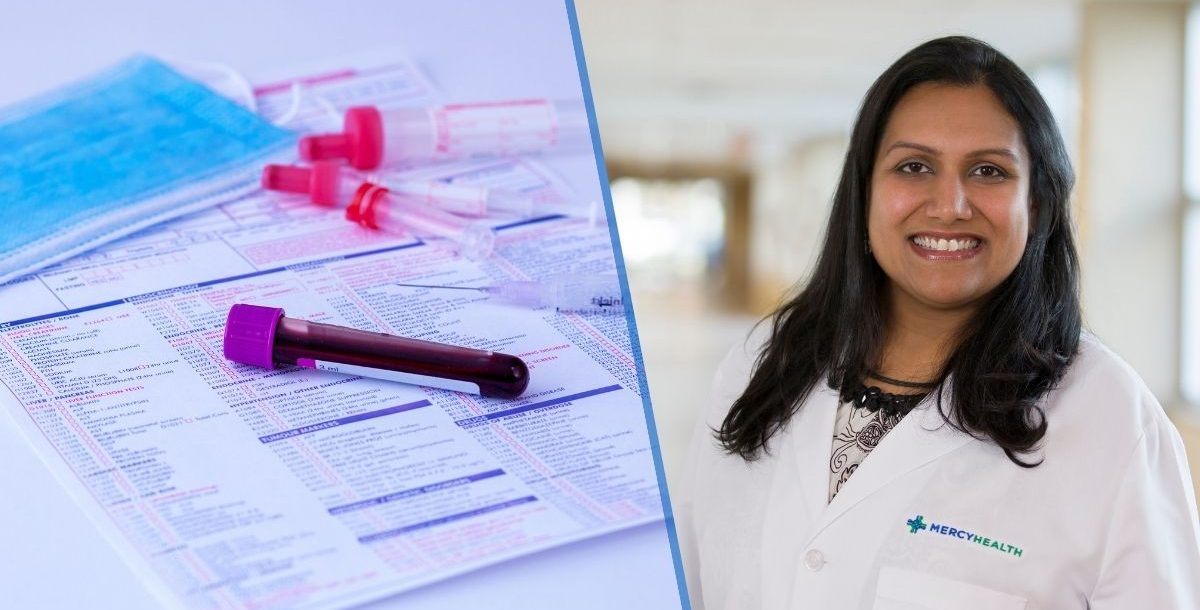Ask Mita Patel, MD, about how to read a pathology report. As a breast surgeon at Mercy Health – Sheffield Breast Surgery as well as the medical director of the breast program in our Lorain market, she’s shared plenty with patients anxious to hear the results.
A pathology report is critical: Along with other tests, the pathology report will provide the doctor as much information as possible to share treatment options with the patient.
Let’s say your doctor suspects you have a type of cancer. They may remove cells or a sample of tissue, such as bone marrow, from your body during a biopsy, surgery or from body fluids. These will be examined by a pathologist, a specially trained doctor, using a microscope and they will conduct tests on the specimen.
If the specimen confirms it, your pathology report will confirm the diagnosis, how much the cancer has developed, how far the cancer has spread and more. Your doctor can share the pathology report with you and their recommended course of treatment.
In fact, you can learn how to read a pathology report yourself. With some background, you can feel comfortable talking to your doctor and making decisions about your care.
What a pathologist does
A pathologist is a medical doctor – either a Doctor of Medicine (MD) or Doctor of Osteopathic Medicine (DO) – and a behind-the-scenes member of your health care team. They work in a lab to study human tissue, blood, urine and other body fluids. Their research helps diagnose all types of diseases, and they may specialize in cancer, blood, nervous system, skin or other areas.
What a pathologist looks for
Communication between doctor and pathologist is vital, according to Dr. Patel. Of her pathology colleagues, she adds, “they’re phenomenal and know what we’re looking for. We talk if I’m looking for something specific. Communication is vital between surgeon and pathology.”
The pathologist observes the specimen first with the naked eye. They record the size, shape, color, weight and what the specimen feels like, along with any abnormalities. This is called the gross description.
The pathologist then slices and affixes the tissue layers to slides and stains the layers with dye to get a good look at different types of cells under a microscope. They record their findings in the microscopic description, which can include the different types of cells and tissues, the arrangement and appearance of cells, how quickly the cells are dividing and locations of cells.
What is in the pathology report?
For cancer – and depending on the types of cancers – the pathology report includes:
- Whether cancer is present, noted as either positive or involved.
- The staging system defines the cancer’s size and spread.
- The TNM system provides critical information:
- T for the primary site and size of the cancerous tumor
- N indicating whether cancer has spread to nearby lymph nodes
- M for metastatic spread of cancer cells elsewhere in the body.
- The grade indicates how likely cancer cells are to grow and spread.
- Molecular-level tests can test for estrogen receptors, progesterone receptors and the protein known as HER2.
- Whether there are cancer cells at the tumor margin, or edge, of the tissue sample, indicating there is likely to be more cancer.
The pathologist also may note the patient’s clinical history or additional tests that may be important to the final diagnosis.
What your doctor looks for
The doctor will use the pathologist’s diagnosis and their own observations and experience to decide the best treatment options for a patient.
“The first thing I look at is what kind of breast cancer it is,” Dr. Patel says. “Then I look at the grading of the tumor. Simply put, this is how aggressive it is. Then it’s the hormonal receptor status – what can make this cancer grow.” She describes a cancer as “feeding itself,” so a doctor considers treatment “to take away the food supply and kill it, generally.”
“The pathologist is critical to the process,” she adds. “A patient comes to you with a mass and there are so many different kinds of cancer and ways to treat it – and that can really affect the outcome for the patient.”
How to follow up with your doctor
Ask questions! Make sure you understand how to read a pathology report and what it means for you.
Dr. Patel says she likes to summarize the pathology report and recommends online sites for the patient to explore. She even encourages second opinions if the patient prefers.
“This is about them, and not me,” she says, adding, “there are many different kinds of breast cancer, and everybody’s journey is different.”
Dr. Patel is always hopeful. “We have amazing research and treatment options,” she explains. “There are numbers of survivors, and that’s very reassuring.”
Learn more about breast cancer as well as the cancer care services we offer at Mercy Health.






